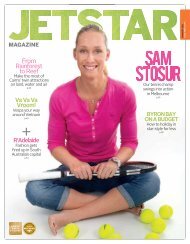january-2010
january-2010
january-2010
Create successful ePaper yourself
Turn your PDF publications into a flip-book with our unique Google optimized e-Paper software.
your wellbeing onboard<br />
SAFETY, SECURITY & COMFORT<br />
Jetstar is a wholly owned subsidiary of Qantas Airways Limited and places the<br />
same emphasis on achieving standards of excellence in safety and security.<br />
QANTAS GROUP SECURITY<br />
The risk-management challenges facing<br />
today’s airline industry remain complex. We<br />
are continually addressing assessed security<br />
threats and risks to minimise vulnerability. The<br />
application of risk-management principles,<br />
innovation and a commitment to excellence<br />
all contribute to creating an effective security<br />
environment. A dedicated Qantas Group<br />
Security Operations Centre monitors global<br />
security 24 hours a day.<br />
Many of our security measures are not<br />
apparent to the public. However, during<br />
check-in and boarding you may have noticed<br />
security measures such as:<br />
• Random explosive trace detection of<br />
passengers and their carry-on luggage.<br />
• Laptops and aerosols being subjected to<br />
enhanced inspection at screening points.<br />
• Increased vigilance at passenger screening<br />
points and increased guarding of our<br />
aircraft and terminals.<br />
Further measures apply to flights to the<br />
United States:<br />
• Additional carry-on baggage searches just<br />
prior to boarding.<br />
• Random baggage searches at check-in<br />
and boarding.<br />
• Passengers selected at random for patdown<br />
inspections, including the removal and<br />
checking of shoes.<br />
CARRY-ON BAGGAGE<br />
Rules are needed to protect you from the<br />
threat of liquid explosives. Liquids, aerosols<br />
or gels in your carry-on baggage must be 100<br />
millilitres/grams or less and must be sealed<br />
in a transparent independently resealable,<br />
one-litre plastic bag. You are only allowed<br />
one plastic bag. You may still carry on board<br />
prescription medicines. Baby products and<br />
non-prescription medicines that you need for<br />
the flight are also allowed. Proof of need may<br />
be required. Please Note: These restrictions do<br />
not apply to checked-in baggage.<br />
SAFETY FIRST<br />
Seatbelts must be fastened during take-off,<br />
landing and when you are seated in case your<br />
aircraft encounters turbulence. Luggage<br />
must be stored in the overhead locker or<br />
under the seat in front of you. The back of<br />
your seat must be upright and the tray table<br />
fastened when the aircraft is taking off and<br />
landing. Please remain seated after landing<br />
until you are invited to leave the aircraft.<br />
Sleeping on the aircraft floor is not permitted.<br />
Please read the safety instruction card in<br />
your seat pocket, noting emergency exits<br />
and location of life jackets. Please watch<br />
90 JANUARY <strong>2010</strong><br />
the safety demonstration prior to take-off.<br />
In an emergency, the crew will give specific<br />
instructions. They may speak assertively and<br />
will require your cooperation.<br />
SMOKING<br />
Government regulations prohibit smoking on<br />
all flights operated by Australian-registered<br />
aircraft. There are smoke detectors in all<br />
toilets and penalties for regulation breaches.<br />
THE IMPORTANCE OF BLOOD<br />
CIRCULATION AND MUSCLE<br />
RELAXATION DURING FLIGHTS<br />
If you have concerns about your health and<br />
flying, Jetstar recommends you seek<br />
medical advice before flying. When you’re<br />
sitting upright and are inactive for a long<br />
period, several things can happen:<br />
• The central blood vessels in your legs can<br />
be compressed, making it harder for the<br />
blood to get back to your heart.<br />
• Muscles can become tense, resulting<br />
in backaches and a feeling of excessive<br />
fatigue during and even after the flight.<br />
• The normal body mechanism for returning<br />
fluid to the heart can be inhibited and<br />
gravity can cause fluid to collect in your feet,<br />
resulting in swollen feet after a long flight.<br />
• Some studies have concluded that<br />
prolonged immobility may be a risk factor<br />
in the formation of blood clots in the legs<br />
– Deep Vein Thrombosis (DVT). Particular<br />
medical conditions may increase the risk<br />
of formation of blood clots if associated<br />
with prolonged immobility. Medical<br />
research indicates that factors which may<br />
give you an increased risk of DVT include:<br />
• Personal or family history of DVT<br />
• Recent surgery or injury, especially to the<br />
lower limbs or abdomen<br />
• Blood disorders leading to increased<br />
clotting tendency<br />
• If you are older than 40<br />
• Oestrogen hormone therapy, including<br />
oral contraceptives<br />
• Pregnancy<br />
• Tobacco smoking<br />
• Former or current malignant disease<br />
• Obesity<br />
• Dehydration<br />
• Heart problems<br />
• Varicose veins<br />
Compression stockings can assist in<br />
preventing swelling of the ankles and feet<br />
and they may improve the blood return<br />
to the body from the lower legs. These<br />
stockings can be purchased from medical<br />
and surgical supply companies and<br />
need to be individually fitted to your leg<br />
measurements. During your flight, move<br />
your legs and feet three or four minutes per<br />
hour while seated and move about the cabin<br />
occasionally.<br />
CABIN PRESSURE<br />
If you are suffering nasal congestion, an ear<br />
infection or allergies, Jetstar recommends<br />
seeking medical advice before flying.<br />
A cold, flu or hay fever can impair your<br />
sinuses. Swollen membranes in your nose<br />
could block the Eustachian tubes between<br />
your nasal passages and your middle ear<br />
chamber. This can cause discomfort during<br />
changes in cabin pressure, particularly<br />
during the aircraft’s descent.<br />
• To “clear” your ears, try swallowing and/or<br />
yawning. This helps open your Eustachian<br />
tubes, equalising the pressure between<br />
your middle ear chamber and your throat.<br />
• When you are flying with an infant, give<br />
them a dummy or feed them during the<br />
aircraft’s descent. Sucking and swallowing<br />
will help the infant equalise the pressure in<br />
their ears.<br />
CABIN HUMIDITY / DEHYDRATION<br />
Humidity levels of less than 25% are<br />
common in the aircraft cabin. This is due<br />
to the low humidity levels of the outside<br />
air supplied to the cabin. Low humidity can<br />
cause drying of the nose, throat and eyes<br />
and it can irritate wearers of contact lenses.<br />
We recommend that you:<br />
• Drink water frequently during flight.<br />
• Drink coffee, tea and alcohol only in<br />
moderation – these drinks act as diuretics,<br />
increasing dehydration.<br />
• Remove contact lenses and wear glasses if<br />
your eyes are irritated.<br />
• Use a skin moisturiser to refresh the skin.<br />
MOTION SICKNESS<br />
This ailment is caused by a conflict between<br />
the body’s senses of vision and equilibrium.<br />
Air turbulence increases its likelihood<br />
because it can cause movement of fluid in<br />
the vestibular apparatus of the inner ear.<br />
If you have good visual cues (keeping your<br />
eyes fixed on a non-moving object), motion<br />
sickness is less likely to occur.<br />
JETSTAR SECURITY POLICY<br />
Jetstar has a strict policy on denying<br />
boarding to any passengers who are<br />
inappropriate in flight or on ground in<br />
comments or behaviour. Jetstar does not<br />
accept any inappropriate comments as<br />
“jokes”. All matters are referred to relevant<br />
authorities for prosecution. Jetstar will seek<br />
to recover all costs incurred as a result of<br />
inflight incidents from those involved.<br />
MORE INFORMATION ON IN-FLIGHT<br />
HEALTH ISSUES CAN BE FOUND AT:<br />
www.qantas.com.au/info/flying/InTheAir/<br />
yourHealthInflight
















